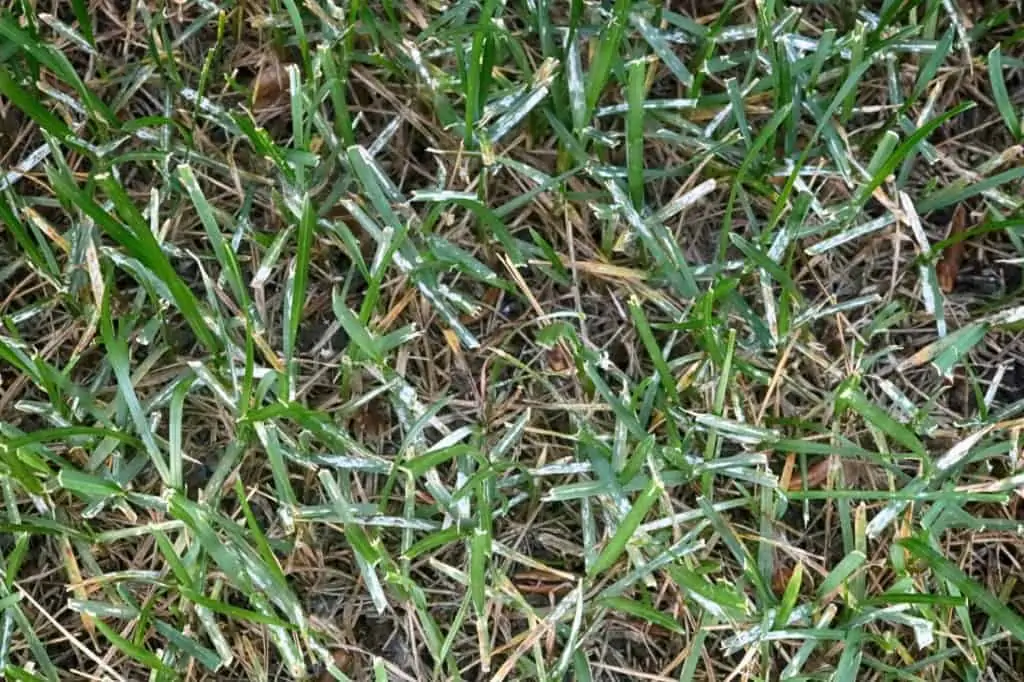If your grass has grown a fuzzy winter coat overnight, there’s a strong possibility that it’s become host to powdery mildew mold.
Powdery mildew diseases can be caused by any number of fungal species under the umbrella Erysiphales, but Podosphaera xanthii is the most notorious of the bunch.
Easily identified by its fluffy, cloudish appearance, powdery mildew mold doesn’t go undiagnosed for long, but early infection is frightfully hard to spot. Most gardeners will only notice the distinctive symptoms when the mold has reached the apex of its growth.
As it usually affects leaves that hang close to the earth, you may never notice it on larger plants, but if it sinks its teeth into your grass, it will be plain to see.

Powdery mildew fungus can reproduce both asexually and sexually, but this reproduction has to take place on the cell host before offspring can be disseminated and the infection spread.
Wooly aphids are the most common mode of transportation, although any sucking insects can be utilized as a vector of infection.
In fact, if you happen to notice an abundance of wooly aphids in your garden, this can be seen as an indicator that infection is on the way.
Thriving in humid yet moderate climates, there are many environments that provide a suitable breeding ground for powdery mildew mold, but temperatures best for spore maturation vary from species to species.
Powdery mildew is especially successful in moist, shaded areas, so an obvious solution is to expose the infected grass to more sunlight and increase the airflow to the area. You can also prevent infection by only watering in the daytime.
If you can’t bring more sunlight into the equation, it might be worth covering that part of your garden in mulch or chippings.
If you wish to treat an already infected area, frequent application of standard fungicides will work; however, if you’re anti-chemical, gardeners have been using a rather surprising alternative for years.
Any guesses? No? Well, drum roll, please…it’s milk! Diluted with water in the ratio 1:10, in some cases, milk is more effective at clearing up the disease than fungicide.
Side Note
If the white matter on your lawn looks more like a cobweb than a fluffy coating, the chances are it is indeed a spider’s web, which you don’t need to worry about (unless you’re afraid of spiders of course), or the spread of a mycelium.
Mycelium is a network of fungal threads known as hyphae. They secrete enzymes that break down the host food source into monomers which are in turn siphoned into the mycelium as sustenance.
Most fungi have a mycelium vegetative phase, so what will eventually grow up from this web and the effect it will have on surrounding plant life is anyone’s guess.
What is Pink Snow Mold?
Pink snow mold sounds pretty innocent, doesn’t it? Well, fellow green thumbs, I’m afraid to say, it’s absolutely not innocent. In fact, it’s the most aggressive biotypes in its order.
Snow mold occurs after lengthy snowfall. It appears as dead spots on turf ranging from three to twelve inches in diameter.
Commonly mistaken for damage to the grass from the snow itself, it’s often left untreated, allowing it to spread into the greater lawn, the spots colliding into large, unsightly, irregular shapes.
The pathogen thrives in wet, unfrozen earth, in rainy and overcast weather conditions. It goes into stasis during the warmer months and as soon as the temperature cools and the rains fall in October through November, it starts reproducing and initiating infection.
It’s a particularly nasty piece of work because during its active period around the end of winter and start of spring when temperatures are still exceedingly low, there are very few other organisms growing. With no competition or obstacles, it has free rein to reproduce and spread.
There are two forms of snow mold, the more benign gray snow mold and the nefarious pink snow mold. Whereas gray snow mold only affects the leaf tissue of grass, the pink variant damages both the roots and crowns too.
It normally spreads via a mycelium, but in spring, it can be spread by the wind, rain, or via animal and human interaction.
Grasses that are especially susceptible to pink snow mold infection include creeping bentgrass, annual ryegrass, perennial ryegrass, fine fescue, tall fescue, and Kentucky bluegrass. That said, no matter which grass is infected, the symptoms are alike.
It’s best treated in the springtime, and unlike gray mold that can be treated without chemicals, combatting pink mold requires fungicide.
Keeping your lawn trim through autumn and ensuring all areas of your grass have access to sunlight and a good airflow can prevent it from occurring in the first place.
It’s also good practice to apply fungicide to your healthy lawn before the first heavy snowfall, but bear in mind that some pink snow molds are resistant to benzimidazole fungicides.

